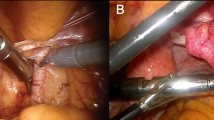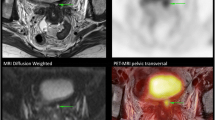Abstract
Introduction
The accurate intraoperative localization of malignant nodes can pose a challenge to the surgical oncologist. Positron emission tomography (PET) scanning has significantly increased our ability to detect suspicious lesions. We investigated the ability of a novel, handheld tool to evaluate suspicious nodes intraoperatively and to correlate its findings with those seen on preoperative PET scan.
Methods
Ten nude rats were inoculated with a lymphogenic mesothelioma tumor line and followed weekly with PET scan studies. When suspicious lymph nodes were found, animals were dissected and the intraoperative amount of tissue radiation was analyzed as “tumor-to-background ratio” (TBR) using the PET probes.
Results
The intraoperative probe was used to guide dissections and select high-risk nodes based on their specific radiotracer uptake. A total of 52 nodes were harvested; eight of these were suspicious on preoperative PET scan studies. Using a TBR of 2.5, the intraoperative probes were able to localize all suspicious nodes previously seen on PET scan. Both gamma (sensitivity: 100%; specificity: 86%; positive predictive value (PPV): 57%; negative predictive value (NPV): 100%) and beta (sensitivity: 88%; specificity: 91%; PPV: 64%; NPV: 98%) probes showed an excellent area under the curve (AUC) in the receiver operating characteristic analysis (ROC). Both probes had an AUC of 0.95 for localizing suspicious nodes on PET scan. Furthermore, the AUC for detecting malignancy for the gamma probe was 0.90 (95% confidence interval (CI), 0.83–0.99), and for the beta probe it was 0.97 (95% CI, 0.94–1.0), suggesting a better performance of the beta probe for detecting malignancy.
Conclusions
This novel tool may be used synergistically with the PET scan examination to maximize intraoperative nodal selection and sampling.




Similar content being viewed by others
References
Buck AK, Reske SN (2004) Cellular origin and molecular mechanisms of 18F-FDG uptake: is there a contribution of the endothelium? J Nucl Med 45(3):461–463
Gambhir SS (2002) Molecular imaging of cancer with positron emission tomography. Nat Rev Cancer 2(9):683–693
Cohn DE, Hall NC, Povoski SP, Seamon LG, Farrar WB, Martin EW Jr (2008) Novel perioperative imaging with 18F-FDG PET/CT and intraoperative 18F-FDG detection using a handheld gamma probe in recurrent ovarian cancer. Gynecol Oncol 110(2):152–157
Gulec SA (2007) PET probe-guided surgery. J Surg Oncol 96(4):353–357
Gulec SA, Daghighian F, Essner R (2006) PET-Probe: evaluation of technical performance and clinical utility of a handheld high-energy gamma probe in oncologic surgery. Ann Surg Oncol 2006 Jul 24. doi:10.1245/ASO.2006.05.047
Sheldon C (1952) Heterotransplantation of human cancer I. Irradiated rats. Cancer Res 12:909–911
Howard RB, Chu H, Zeligman BE, Marcell T, Bunn PA, McLemore TL et al (1991) Irradiated nude rat model for orthotopic human lung cancers. Cancer Res 51(12):3274–3280
Kjonniksen I, Nesland JM, Pihl A, Fodstad O (1990) Nude rat model for studying metastasis of human tumor cells to bone and bone marrow. J Natl Cancer Inst 82(5):408–412
Higashi T, Saga T, Ishimori T, Mamede M, Ishizu K, Fujita T et al (2004) What is the most appropriate scan timing for intraoperative detection of malignancy using 18F-FDG-sensitive gamma probe? Preliminary phantom and preoperative patient study. Ann Nucl Med 18(2):105–114
Bleiweiss IJ (2006) Sentinel lymph nodes in breast cancer after 10 years: rethinking basic principles. Lancet Oncol 7(8):686–692
Mathelin C, Salvador S, Croce S, Andriamisandratsoa N, Huss D, Guyonnet JL (2007) Optimization of sentinel lymph node biopsy in breast cancer using an operative gamma camera. World J Surg Oncol 5:132
Keshtgar MR, Ell PJ (2002) Clinical role of sentinel-lymph-node biopsy in breast cancer. Lancet Oncol 3(2):105–110
Nason KS, Anderson BO, Byrd DR, Dunnwald LK, Eary JF, Mankoff DA et al (2000) Increased false negative sentinel node biopsy rates after preoperative chemotherapy for invasive breast carcinoma. Cancer 89(11):2187–2194
Fisher B, Redmond C, Poisson R, Margolese R, Wolmark N, Wickerham L et al (1989) Eight-year results of a randomized clinical trial comparing total mastectomy and lumpectomy with or without irradiation in the treatment of breast cancer. N Engl J Med 320(13):822–828
van Dongen JA, Bartelink H, Fentiman IS, Lerut T, Mignolet F, Olthuis G et al (1992) Randomized clinical trial to assess the value of breast-conserving therapy in stage I and II breast cancer, EORTC 10801 trial. J Natl Cancer Inst Monogr 11:15–18
Port ER, Fey J, Gemignani ML, Heerdt AS, Montgomery LL, Petrek JA et al (2002) Reoperative sentinel lymph node biopsy: a new option for patients with primary or locally recurrent breast carcinoma. J Am Coll Surg 195(2):167–172
Daghighian F, Mazziotta JC, Hoffman EJ, Shenderov P, Eshaghian B, Siegel S et al (1994) Intraoperative beta probe: a device for detecting tissue labeled with positron or electron emitting isotopes during surgery. Med Phys 21(1):153–157
Gonen M (2007) Analyzing receiver operating characteristic curves with SAS, 2007. SAS Press, Cary
Bellamy E et al (2007) The role of PET/CT in the investigation of patients presenting with pleural abnormalities. Cancer Imaging 7:S116
Disclosures
Drs. Segundo J. González, Joyce Wong, Lorena González, Peter Brader, Maureen Zakowski, Mithat Gönen, Young Fong, and Vivian E. Strong have no conflicts of interest or financial ties to disclose.
Author information
Authors and Affiliations
Corresponding author
Rights and permissions
About this article
Cite this article
González, S.J., Wong, J., González, L. et al. Novel handheld PET probes provide intraoperative localization of PET-avid lymph nodes. Surg Endosc 25, 3214–3221 (2011). https://doi.org/10.1007/s00464-011-1696-z
Received:
Accepted:
Published:
Issue Date:
DOI: https://doi.org/10.1007/s00464-011-1696-z




